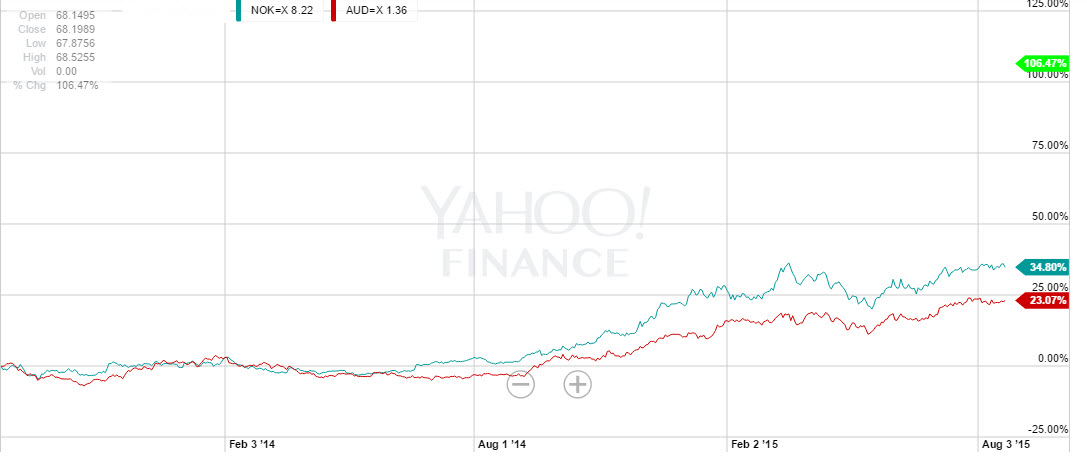
Will Oil continue to fall? That is still a question with no definitive answer. But as I emphasized in my latest article on Oil, there's a growing chance of an Oil rebound. And even if an Oil rebound doesn't eventually materialize it's prudent to have a strategy in place. In this article, we'll focus on a strategy that is slightly less common. Of course, you could just take a naked bet on an Oil-oriented currency, e.g. the Norwegian Krone or the Canadian Loonie. But those trades could easily and quickly tank if the signals for an Oil rebound turn out to be false. So what is this unconventional way? Don't short/buy a petro currency against a currency unrelated to oil (e.g. Dollar, Yen or Euro). Instead, buy or sell a petro currency vs. a peer that is deemed a commodity currency, but a non-petro one. That could prove to be a much safer play.
Trading Correlated Currencies Reduces Risk
When you trade correlated currencies against each other, such as the NOK and Aussie, you have a reduced upside. While that's a true statement, there are also big benefits. When there is a short-term gap in performance, there is a higher likelihood that this gap will close. And that provides an opportunity that is rather easy to spot. Then, too, the downside is also more limited, so while the profit might be reduced so are the risks. In fact, if you compare the potential of correlated trades vs. uncorrelated, those trends tend to be slower moving and generate fewer profits. However, it compensates the investor with more certainty (the gaps almost always close), making them less volatile and less risky.
Of course, there is a caveat. In this case, you have to know how to do your homework and spot the gaps that are cyclical. For example, the gap in performance between the NOK and the Ruble, both commodity currencies, is not cyclical. That’s because it is largely driven by sanctions imposed on Russia that won’t soon be lifted. What about a gap between the CAD and the Aussie or between the NOK and the Aussie? Well, either gap could be closed if Oil rebounds. That, then, is clearly cyclical.
Down to Practice – NOK vs. AUD
Let's say you want to play an oil rebound if/when it occurs but are afraid of being hit if it proves wrong. When you buy a currency such as the NOK against a currency such as the Aussie you have some sort of downside protection. Why? When/if commodities fall, both currencies will lose and your trade won’t incur losses. That likely wouldn't be the case if you had taken an outright bet on the NOK against say the Dollar or Yen.
Meanwhile, what if Oil does bounce back? With the Krone more oriented towards Oil than the Aussie and less oriented to China, you might even gain some upside. Below is a classic example of just this scenario; how the Aussie and the Krone traded against the Dollar. Since February 2014, as oil prices tumbled, the NOK has lost roughly 35% of its value. Over the same period, the Aussie shed roughly 23% of its value. Essentially, the Aussie outperformed the NOK by 12% which is not too bad for an FX trade. And it's much less riskier than the 35% and 23% losses incurred on the Aussie or NOK trades against the Dollar. Given China's severe doldrums, the case for taking the opposite trade (and betting that the gap will close) could potentially yield roughly 12% in the next months.

Chart courtesy of Yahoo Finance
Look for my post next week.
Best,
Lior Alkalay
INO.com Contributor - Forex
Disclosure: This article is the opinion of the contributor themselves. The above is a matter of opinion provided for general information purposes only and is not intended as investment advice. This contributor is not receiving compensation (other than from INO.com) for their opinion.

What are the entry criteria?
what are the exit criteria?
what is the profi exit?
what is the loss exit?
what is the time exit?
IF the trade is not moving as expected
after how many days, do you exit
and close out the trade?
Great concept. An easy way to take a look at the pair trade viability of such FX Triangular trades (NOK/CAD/USD) is to use TradingView's "formula as a symbol"
For instance:
https://www.tradingview.com/chart/?symbol=NOKUSD/CADUSD
But you can get much more elaborate with the math in your symbol selection
You can add JPY which is negatively affected by oil prices...
https://www.tradingview.com/chart/?symbol=JPYUSD/(NOKUSD/CADUSD)
What I like to do is try and find a set of currencies, when arranged in a certain pattern, give me a compelling oscillation, line a sin wave.